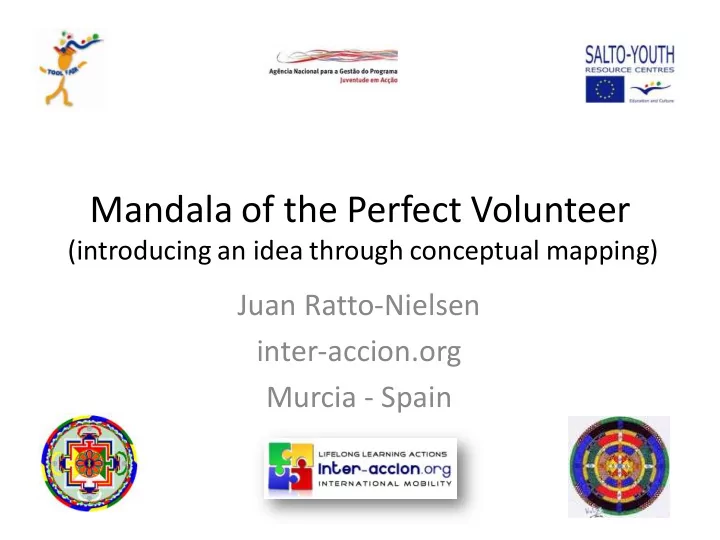

Mandala of the Perfect Volunteer (introducing an idea through conceptual mapping) Juan Ratto-Nielsen inter-accion.org Murcia - Spain
General Description • Background This tool was designed for the workshop on Voluntary Work in the EVS pre-departure training course, as a way to enquiry volunteers about voluntary work and introduce relevant concepts related to the subject through artistic expression. • Aims Make future EVS volunteers reflect about voluntary work and introduce relevant concepts related to the subject through artistic expression in order to promote discussion and debate
General Description • Objectives 1. To explore and discover the concept of voluntary work in its complex construction and deconstruction, starting from the perception of participants and their personal identities, environments and realities. 2. To raise awareness among participants about volunteering as an option for active participation in civil society. 3. Promote self-reflection and learning of the concepts behind Voluntary Work. 4. Encourage discussion and debate about the topic.
Methodology: Mandalas • Mandala means 'circle' in the Sanskrit language, and mandala art refers to symbols that are drawn, sketched or painted in a circular frame. • Mandala art has been used throughout the world as a process of self-expression, in the service of personal growth and spiritual transformation. • Tibetan Buddhism has employed mandala art for thousands of years to capture the images of the countless demons and gods which it believes both plague and uplift humanity. • The psychoanalyst Carl Jung saw the mandala as "a representation of the unconscious self," and believed his paintings of mandalas enabled him to identify emotional disorders and work towards wholeness in personality.
Methodology: Mandalas • How to look at Mandalas ? • The very fact that mandalas are drawn round can lead us to an experience of wholeness when we take the time to make them and then wonder what they mean. • In the strict use of the mandala, there is a central point or focus within the symbol from which radiates a symmetrical design. • This suggests there is a center within each one of us to which everything is related, by which everything is ordered, and which is itself a source of energy and power.
Methodology: Mandalas • MANDALA CONCEPT MAP • Information is presented within a format of interlocking geometric shapes. • A "telescoping" factor creates compelling visual effects which focus the attention and thought processes of the viewer.
Methodology: Concept Maps • A concept map is a special form of a web diagram for exploring knowledge and gathering and sharing information. • Concept mapping is the strategy employed to develop a concept map. • A concept map consists of nodes or cells that contain a concept, item or question and links. The links are labeled and denote direction with an arrow symbol. The labeled links explain the relationship between the nodes. • The arrow describes the direction of the relationship and reads like a sentence.
Methodology: Concept Maps • Uses of a concept map • Develop an understanding of a body of knowledge. • Explore new information and relationships. • Access prior knowledge. • Gather new knowledge and information. • Share knowledge and information generated. • Design structures or processes • Problem solve options.
Methodology: How? • Critical Questions: • What is the central word, concept, research question or problem around which to build the map? • What are the concepts, items, descriptive words or telling questions that you can associate with the concept, topic, research question or problem?
Methodology: How? • Use a top down approach, working from general to specific or use a free association approach by brainstorming nodes and then develop links and relationships. • Use different colors and shapes for nodes & links to identify different types of information. Use different colored nodes to identify prior and new information. • Gather information to a question in the question node.
Tool Assestment • The Learning Process: • Importance of the background and culture of the learner • Learning as an active, social process • Dynamic interaction between task, instructor and learner • Assessment tool
Tool Assestment • Scope of the Learning Process: • Knowledge is discovered as an integrated whole. • Engaging and challenging the learner. • Balance between the degree of structure and flexibility.
Final Remarks • This tool can be used to introduce any concept by presenting its different elements through a concept map. • In previous evaluations by the training team, the need to deepen and / or learn more about the “formal” or legal concept of voluntary work was pointed out. • It is possible, therefore, to use this tool complemented by further information. • However, this depends on the objectives set by the trainer and time availability.
Recommend
More recommend